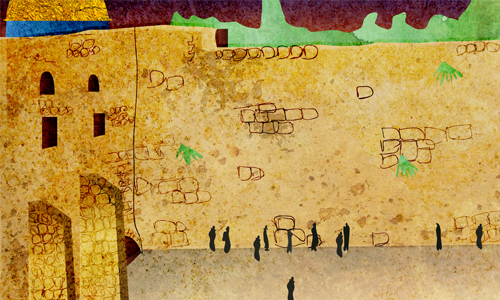17th of Tammuz: History, Laws and Customs
The fast actually commemorates five tragic events that occurred on this date:
- Moses broke the tablets when he saw the Jewish people worshipping the Golden Calf.
- During the Babylonian siege of Jerusalem, the Jews were forced to cease offering the daily sacrifices due to the lack of sheep.
- Apostomos burned the holy Torah.(1)
- An idol was placed in the Holy Temple.(2)
- The walls of Jerusalem were breached by the Romans, in 69 CE, after a lengthy siege. (Three weeks later, after the Jews put up a valiant struggle, the Romans destroyed the second Holy Temple on the 9th of Av.) The Jerusalem Talmud maintains that this is also the date when the Babylonians breached the walls of Jerusalem on their way to destroying the first Temple.
- Healthy adults—bar- or bat-mitzvah age and older—abstain from eating or drinking between dawn and nightfall. Click here for exact times in your location.
- Pregnant and nursing women may not have to fast. Someone who is ill should consult with a rabbi. Even those exempt from fasting, such as ill people or children, shouldn’t indulge in delicacies or sweets.
- It is permitted to wake up early before the fast begins and eat, provided that prior to going to sleep one had in mind to do so.
- During the morning prayers we recite selichot (penitential prayers), printed in the back of the prayerbook. The “long Avinu Malkeinu” is recited during the morning and afternoon prayers.
- The Torah is read during the morning and afternoon prayers. The reading—the same for both morning and afternoon—is Exodus 32:11–14 and 34:1–10, which discusses the aftermath of the Golden Calf incident, how Moses successfully interceded on the Israelites’ behalf and attained forgiveness for their sin. After the afternoon Torah reading, the special fast-day haftarah, Isaiah 55:6–56:8, is read.
- During the Amidah prayer of the afternoon service (Minchah), those who are fasting add the paragraph Aneinu in the Shema Koleinu blessing. (It is also added in the cantor’s repetition of the Amidah in both the morning and afternoon services, as its own blessing between the blessings of Re’eh and Refa’einu.) Additionally, the priestly blessing is also added in the repetition of the Amidah in the afternoon service.
- If the 17th of Tammuz falls on Shabbat, the fast is postponed until Sunday. Click here for more about this Shabbat.
Abstaining from food and drink is the external element of a fast day. On a deeper level, a fast day is an auspicious day, a day when G?d is accessible, waiting for us to repent.
The sages explain: “Every generation for which the Temple is not rebuilt, it is as though the Temple was destroyed for that generation.” A fast day is not only a sad day, but an opportune day. It’s a day when we are empowered to fix the cause of that destruction, so that our long exile will be ended and we will find ourselves living in messianic times; may that be very soon.
1.Historians have long debated when this occurred: some maintain that Apostomos was a general during the Roman occupation of Israel, while others contend that he lived years earlier and was an officer during the Greek reign over the Holy Land.
2. This event is also shrouded in controversy: some say that this too was done by Apostomos, while others say that this was done by King Manasseh of Judea.
Sefira Ross is a freelance designer and illustrator whose original creations grace many Chabad.org pages. Residing in Seattle, Washington, her days are spent between multitasking illustrations and being a mom.
Source: Chabad.org
